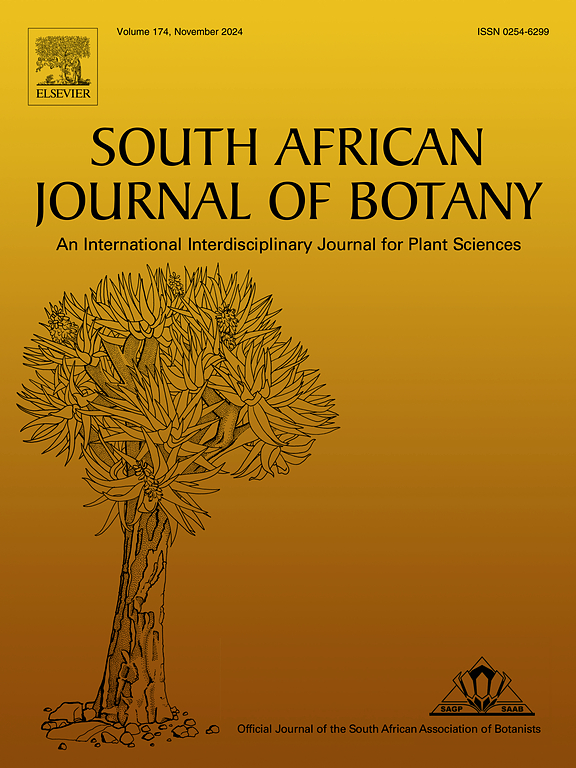植物生长调节剂的研究和新兴的生物技术方法在黄花蒿:综合综述
IF 2.7
3区 生物学
Q2 PLANT SCIENCES
引用次数: 0
摘要
黄花蒿(Artemisia annua L.)是一种著名的中国药用植物,是青蒿素的主要商业来源,青蒿素是一种有效的抗疟原虫化合物,对疟疾治疗至关重要。然而,由于该植物的自然产量较低(干重的0.1 - 0.9%),全球对青蒿素的需求大大超过了供应。植物生长调节剂(pgr)是一类多功能农用化学品,能够调节植物的生长、生理和代谢。在复杂的信号级联中,pgr单独或通过串扰作用,引发特定的反应,提高生物量和次生代谢物的产生。在黄花蒿中,战略性PGR应用已显示出巨大的潜力,可以改善其体内和体外生长动态、应激恢复能力以及生物活性化合物(如青蒿素)的生物合成。生物技术策略的最新进展,包括体外培养系统、代谢工程和生物过程优化,已经证明了pgr在最大限度地提高青蒿素产量方面的潜力。这些策略利用快速微繁、分子方法(包括转基因)和基于细胞的培养技术来提高作物产量和次生代谢物含量。此外,组学驱动的研究为支持pgr介导的青蒿素生物合成的分子机制提供了详细的见解,从而实现了精确和有针对性的应用,从而提供了可持续的解决方案,以满足不断增长的全球需求。本文对稻瘟病植物pgr的生物技术应用进行了综述。它强调了植物激素的基本作用和它们在调节生物和非生物胁迫反应中的相互作用。本文还重点介绍了pgr在植物再生中的外源应用,包括组织培养、次生代谢物诱导、青蒿素生物合成途径的优化等。此外,这项工作强调需要将pgr和转基因植物应用整合到黄花蒿中,作为结合生物技术工具、组学见解和田间验证的创新和可扩展策略的一部分。本综述为植物生物技术的研究人员和学生提供了有价值的见解,为推进黄花蒿的培养和代谢优化以提高青蒿素的产量提供了实用的知识。本文章由计算机程序翻译,如有差异,请以英文原文为准。
Plant growth regulator studies and emerging biotechnological approaches in Artemisia annua L.: A comprehensive overview
Artemisia annua L., a prominent Chinese medicinal plant, serves as the primary commercial source of artemisinin, a potent anti-plasmodial compound critical in malaria treatment. However, global artemisinin demand significantly exceeds supply due to the plant's low natural yield (0.1–0.9 % dry weight). Plant growth regulators (PGRs) are a versatile class of agrochemicals capable of modulating plant growth, physiology, and metabolism. Acting individually or through cross-talk in complex signaling cascades, PGRs elicit specific responses that enhance biomass and secondary metabolite production. In A. annua, strategic PGR applications have shown great potential to improve both in vivo and in vitro growth dynamics, stress resilience, and biosynthesis of bioactive compounds like artemisinin.
Recent advancements in biotechnological strategies, including in vitro culture systems, metabolic engineering, and bioprocess optimization, have demonstrated the potential of PGRs to maximize artemisinin production. These strategies leverage rapid micropropagation, molecular approaches (including transgenics), and cell-based culture techniques to enhance crop yield and secondary metabolite content. Furthermore, omics-driven research has provided detailed insights into the molecular mechanisms underpinning PGR-mediated artemisinin biosynthesis, enabling precise and targeted applications and thus offering sustainable solutions to meet rising global demands.
This review presents a comprehensive analysis of the biotechnological applications of PGRs in A. annua. It highlights the fundamental roles of plant hormones and their interactions in regulating responses to biotic and abiotic stresses. The review also emphasizes the targeted exogenous application of PGRs in plant regeneration through tissue culture, secondary metabolite elicitation, and the optimization of the artemisinin biosynthetic pathway. Furthermore, this work highlights the need to integrate PGRs and transgenic plant applications in A. annua as part of an innovative and scalable strategy that combines biotechnological tools, omics insights, and field validation. This review offers valuable insights for researchers and students in plant biotechnology, providing practical knowledge to advance the cultivation and metabolic optimization of A. annua for enhanced artemisinin production.
求助全文
通过发布文献求助,成功后即可免费获取论文全文。
去求助
来源期刊

South African Journal of Botany
生物-植物科学
CiteScore
5.20
自引率
9.70%
发文量
709
审稿时长
61 days
期刊介绍:
The South African Journal of Botany publishes original papers that deal with the classification, biodiversity, morphology, physiology, molecular biology, ecology, biotechnology, ethnobotany and other botanically related aspects of species that are of importance to southern Africa. Manuscripts dealing with significant new findings on other species of the world and general botanical principles will also be considered and are encouraged.
 求助内容:
求助内容: 应助结果提醒方式:
应助结果提醒方式:


